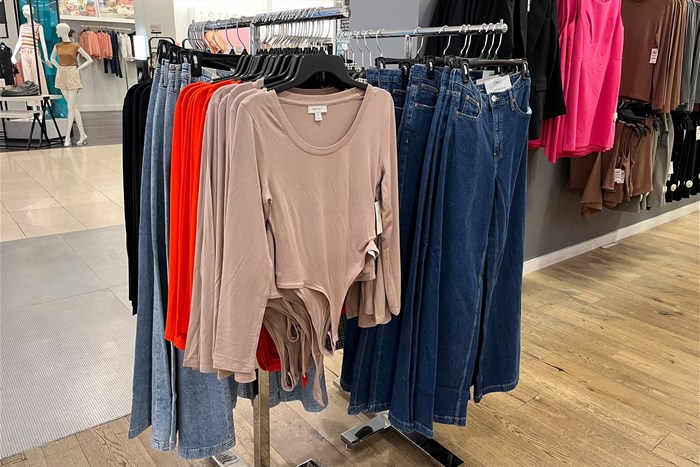
Top stories


Logistics & TransportIata urges global safeguards for aircraft systems as 5G/6G rollout continues
17 hours

AgricultureAgricultural exports from Africa are not doing well. Four ways to change that
Lilac Nachum 18 hours



Other major companies, including VF Corp and Permira-owned Reformation, are also touting warm-weather styles made with Tencel, a lyocell fibre that textile manufacturer Lenzing says is more absorbent than cotton.
The push comes as clothing retailers, whose sales dipped as inflation-weary consumers prioritised essentials over discretionary purchases, amp up their marketing of "cooling" garments as heat waves batter at least three continents.
Apparel manufacturers and sellers are banking on lightweight materials and performance fabrics aimed at offering more relief than traditional cotton and polyester knits, as well as high-tech fibres they say offer wearers "active" cooling.
Many such textiles have been used for years, especially in athletic clothing from brands such as Lululemon, according to Jess Ramirez, an analyst for Jane Hali & Associates. But with rising temperatures, more retailers are promoting them for hot weather and expanding into year-round styles as winters grow warmer.
Macy’s officials told Reuters its newest line includes a $150 trench coat made with lyocell and $24.50 tee-shirts made with modal - two silky fibres produced from wood pulp that textile experts say are lightweight and breathable.
The department store chain is expanding such inventory and will market some of those items as "breathable" and "cooling," Macy’s senior vice-president of private brand strategy, Emily Erusha-Hilleque said. Macy's conducts quality tests to back the claims, she added, but the company declined to offer details.
Women's brand Reformation in June began selling new skirts, bottoms and dresses with Tencel, which the company calls "foundational" to its products.
Few retail market firms track specific sales of "cooling" clothes, but related fabric manufacturing is rising.
Tencel-maker Lenzing expanded production with a Thailand facility last year, its senior business development manager Sharon Perez said, citing growing demand from brands including Patagonia and VF's North Face despite costs of up to $0.10 more per pound than other materials.
Overall, global production of cellulose-based fibres including lyocell, modal and cupro grew more than 10% to 7.2 million tons in 2022, according to the nonprofit Textile Exchange.
PT Golden Tekstil, an Indonesian mill whose clients include Macy’s, PVH and Ralph Lauren's Polo brand, boosted its "performance" fabric production by 20% to 30% in recent years, its US design director Beth Carter Schlack told Reuters.
Still, it also remains unclear whether materials marketed as cooling can lower body temperature or simply help wearers feel more comfortable.
Textile industry groups have developed tests to assess cooling, mostly by measuring a fabric's ability to distribute moisture and dry out quickly as a proxy, according to the American Association of Textile Chemists and Colorists.
But no specific tests are required before companies can make cooling claims, and not all lab findings necessarily translate to actual use, said Roger Barker, who studies textiles at North Carolina State University.

Companies are also producing more garments with performance fabrics such as Lycra’s Coolmax, a polyester yarn designed to wick sweat away to evaporate.
Fast Retailing's Uniqlo has expanded its Airism line using super-fine, smooth fibres made from polyester and cupro, which is made from cotton waste, that it says dry quickly and feel cool.
Kirsty Wilson, a materials consultant who has worked with major retailers, told Reuters more brands are using "performance yarns" such as Coolmax that dry more quickly than cotton.
J. Crew and H&M are among the retailers using Coolmax, which is also used in bedding, sleeping bags and other products geared toward warm, humid weather.
Hotter temperatures are also driving more advanced "active cooling" fibre technology by embedding materials that trap and release heat rather than the passive cooling offered by most materials to-date.
While sweat-wicking clothes can speed up the evaporation of sweat from the body, which is how humans naturally stay cool, there is a limit to how much relief such passive cooling provides, said Barker, who heads North Carolina's Textile Protection and Comfort Centre.
This summer, Columbia Sportswear released a new sweatshirt with its updated Omni-Freeze Zero Ice fabric, combining "active" technology with wicking properties and a print it says absorbs sweat.
Creating new styles for hot environments will "remain an area of focus," Haskhell Beckham, the company's vice president for innovation, told Reuters.
Other retailers have turned to similar fabrics, including those from Atlanta-based textile manufacturer Brrr that embed cooling minerals.
Brrr works with 47 brands - including Adidas, which launched golf polo shirts using its material in March - and has at least doubled production since 2018, according to its vice-president of sales, Julie Brown.
While many garments with Brrr fabrics target hot summers, there’s growing demand for modified base layers and cold-weather clothing as more shoppers experience unseasonably warm winters, Brown added.
"If you're out walking or hiking or skiing, a lot of people want that cooling effect, even in wintertime," she said.

Reuters, the news and media division of Thomson Reuters, is the world's largest multimedia news provider, reaching billions of people worldwide every day.
Go to: https://www.reuters.com/